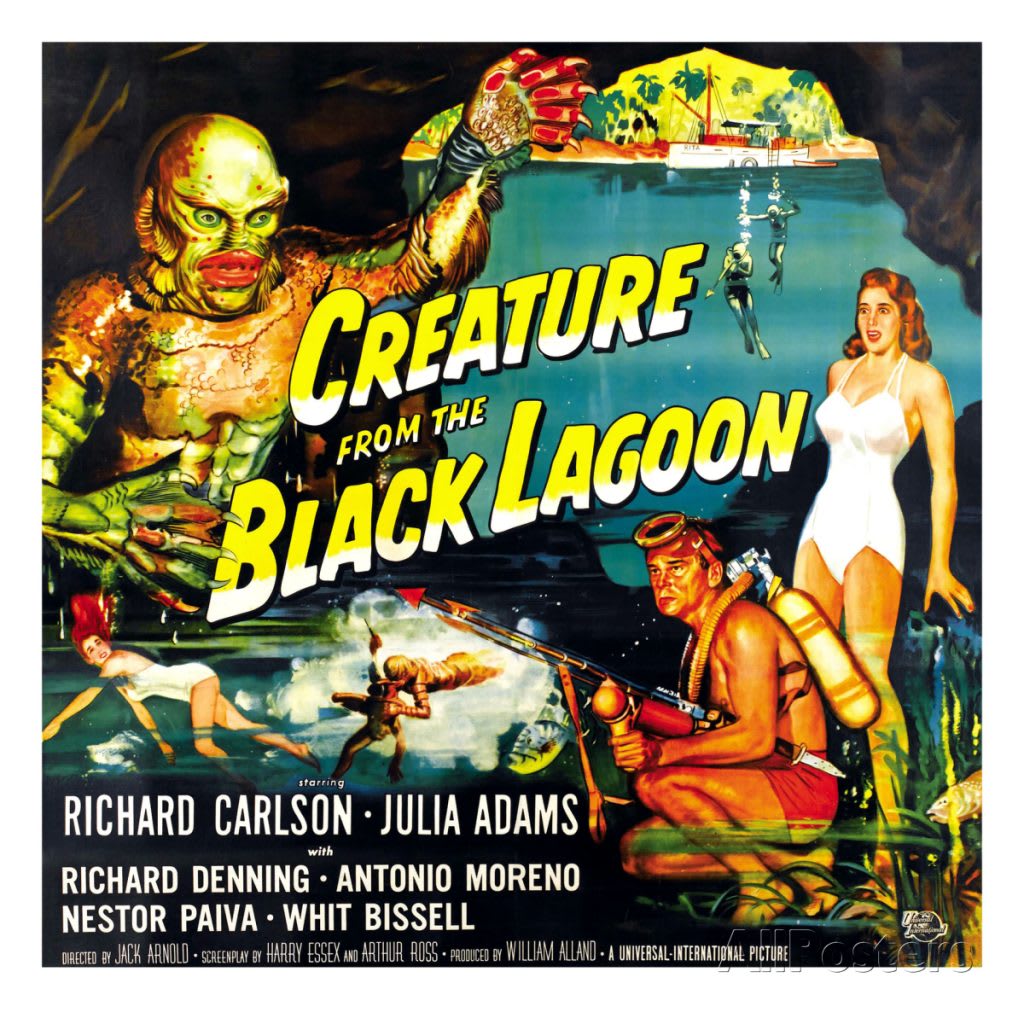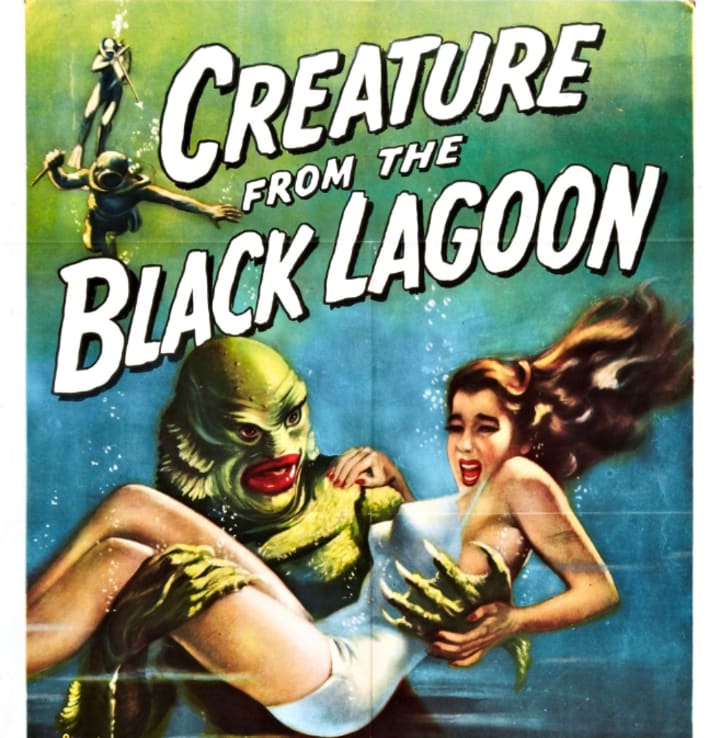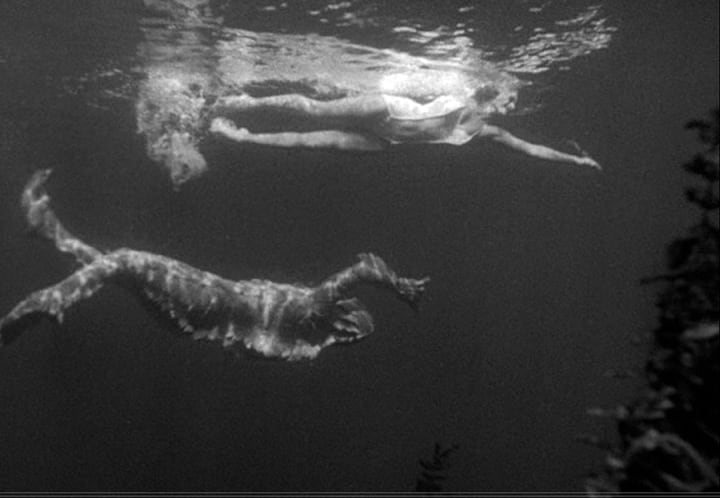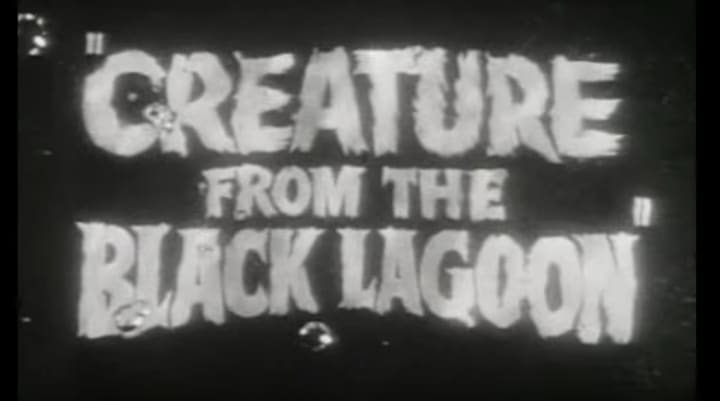'The Creature From The Black Lagoon' - A Sci-Fi Epic Environmental Horror Movie
The Creature's Tragic Predicament Illustrates Our Delicate Environmental Balance

“The restless seas rise, find boundaries, are contained. Now in their warm depths, the miracle of life begins. In infinite variety, living things appear, change and reach the land, Leaving a record of their coming, of their struggle to survive and of their eventual end. The record of life is written on the land, where fifteen million years later in the upper reaches of the Amazon, man is still trying to read it.”
- The Creature From The Black Lagoon (1954) - Film Opening Narration
What’s in a name if you’ve been a certified pop culture icon for over six decades? Some of us call him The Gill Man or The Fish Man. The crew on the Hollywood film set which created him, called him The Beastie. Whatever you choose to call him, The Creature From The Black Lagoon has become synonymous with scaly, fishy horrors hiding underneath deep, unfathomable water. Long before author Peter Benchley and director Steven Spielberg gave the world the ocean dwelling menace, Jaws (1975), the beloved Gill-Man reigned supreme as the most terrifying waterborne cinematic creature to ever prey upon mankind.
Horror movies aren’t normally associated with providing incisive scientific or cautionary ecological commentary. So, when you watch The Creature From The Black Lagoon, be prepared to absorb more than the usual horror film concerns. At times, it plays like a fun, crash course in evolution and ecological study. The Universal 1950's classic may not be eligible to ever win hardcore awards for its legitimate scientific accuracy, but real admiration must be given to its spirited speculation on the evolutionary record of our planet and its overall feeling of sci-fi verisimilitude.
Before it was one of today’s most pressing concerns, the Earth’s delicate environmental balance - or lack thereof - was subtly explored in this now iconic horror film. On its surface, The Creature From The Black Lagoon, appears as merely another fright flick from the Hollywood studio who gifted the world with so many fun scare romps. Like its older Universal cinematic brethren, Frankenstein or TheWolfman, it shares the same kind of sympathetic monster status. However, if you dig deeper, this 1954 thriller showcases a far meatier, even cautionary scenario, wherein a group of scientists are terrorized by a web footed, gill breathing warning. The film’s subtext or ultimate message? Treating our environment badly and traipsing about clumsily in other species ecosystems ultimately may end up costing you and those around you their lives or sanity.
A Black Lagoon Tempts Audiences To Take A Swim

1954's 3D Sci-Fi Release
Producer William Alland, a friend and collaborator of director Orson Welles (Citizen Kane), was at a dinner party when fellow guest, Gabriel Figueroa, regaled the Hollywood bash with tales of half man, half fish creatures living and co-existing alongside native peoples of the Amazon. Although most of the group thought Figueroa related a tall tale, Alland fascinated by what he heard, wrote up a summary entitled The Sea Monster. Years later, Alland managed to get Universal interested and the future classic was put into production.
Despite the gimmicky trappings of it being filmed in Hollywood’s first, and by today's standards, primitive flirtation with the 3D process, and it being marketed as a thrilling, monster flick, Creature attempts to at least provide a veneer of real world scientific background which bolsters the otherwise larger than life, pulpy proceedings.
After a mysterious fossilized limb (skeletal & webbed hand) is excavated, it’s taken for closer study by a group of prominent scientists. This prompts a discussion about fish and other undersea creatures migrating onto the land. The evolutionary path of Earth’s primitive, water dwelling lifeforms becomes a kind of casual focal point for the science fiction story. It’s a reminder that even the most advanced lifeforms got their embryonic start swimming in the oceans. An enormous lungfish is shown swimming in a tank and referenced in its evolutionary path. One of the characters comments:
“This lungfish - the bridge between fish and the land animal. How many thousand of ways nature tried to get life out of the sea and onto the land. This one failed. He hasn’t changed in millions of years. But here… here we have a clue to an answer. Some day, spaceships will be travelling from Earth to other planets. How are human beings going to survive on those planets? The atmosphere will be different… the pressures will be different. By studying these and other species, we add to our knowledge of how life evolved, how it adapted itself to this world. With that knowledge, perhaps we can teach men to adapt themselves to a some new world of the future.”
Connecting our earth bound, yet water dwelling creature to the elegant future of space exploration may be a bit too ambitious for some, but even slight speculation at helping out with humanity’s future space exploration certainly sounds good. It manages to keep up a vibe for even more of a sci-fi angle to the story.
What to make of the skeletal hand with webbed fingers? The scientists gather to discuss the placement of the fossil on the Geologic Timeline - a geology reference guide which scientists use to provide a rough history of geology and life, by closely examining the fossil record. One asks, “Could it possibly belong to a Pleistocene man? To which another character responds, “Chances are greater that it belonged to an amphibian.”
If the film always strives to get the science backdrop interesting and engaging, if not at all authentic, it also effectively cultivates a ‘Beauty & The Beast’ kind of fairy tale love story - unrequited and forever unfulfilled as it ultimately becomes.
An Elegant, Underwater Love Dance

A Gill-Man Beast Finds A Beauty
Actress Julie Adams plays the beautiful Kay Lawrence. She's the object of fascination and even adoration of the apparently lonely Gill-Man - who is played by actor Ben Chapman when walking on the land, and Ricou Browning, who swam in the skin tight costume during the elegant underwater swimming sequences.
Our Creature gets his first look at Adams when she bravely takes a dip to go swimming. Once our fishy folk hero gets a gander at this gorgeous gal, there’s simply no turning back for the fully besotted Gill-Man. What’s most entertaining, and for film buffs educational, is the elegant, even poetic underwater ‘Love Dance’ between the two.
Fans of Jaws can never forget the pulse pounding, nightmarish sequence of the now legendary Great White slaughtering his first victim. The action packed blockbuster opens with a scene which seems eerily inspired by one of the most memorable ones in Black Lagoon. Here, a full 21 years prior, the Gill-Man shadows and lovingly stalks his target much like in Spielberg’s feature film shark tank.
However, instead of wanting to snap up actress Adams and snack on her like a human sushi roll, the inquisitive Creature mirrors her swim strokes and even playfully touches her legs. The landmark underwater photography coupled with the graceful performers swimming, along with the emotional musical score, make it a truly breathtaking sequence.
When other scientists aboard the Rita scoff at the possibility of a still alive Gill-Man after all those millions of years since the fossil skeletal hand was still attached to its owner, Kay Lawrence again references the lungfish - or the Kamongo - a fish which can breath oxygen. Her logic? If the lungfish is still alive and well, why can’t a Gill-Man still be swimming about these waters today?
All the educated analysis, speculation and observation would have been fine. It’s when the scientists seek to capture the Gill-Man when the movie sub-text shadow of ecological disaster looms largest.
Poisoning The Lagoon of Life

A Lagoon Full Of Life
Early on in the story, as the riverboat Rita makes its way down along the enigmatic Black Lagoon, the Rita's Captain, Kay Lawrence and Dr. David Reed, played by Richard Carlson, discuss the hearty life inhabiting the Amazon
Reed muses on the Amazon's super sized variety of fauna, “Even the animals here grow as they did in Devonian forests. The anteaters are giant with the strength of a bear. The centipede grows to be a foot long. The Amazonian rat is as big as a sheep.”
The Captain responds, “Don’t forget our catfish. They grow to be nine feet long! And killers! Like everything in this jungle. All killers.”
Filmed at Universal Studios and also on location in Florida, the movie makers create a convincing stand in for the actual natural beauty of the Amazon. It’s clearly established how full of life this area of our planet teems with and hosts.
And not much later, to capture the Gill-Man, loads of a poison are dumped into this complex ecosystem.
The scene plays as a tremendously heart rending one for several reasons. After the poison is placed into the water, dozens of dead fish go belly up to the surface. When the Gill-Man doesn’t appear belly up as well, additional poison is thrown into the water, clouding its pristine beauty and affecting even more lagoon wildlife.
Amid all this toxic damage to the Amazon, Richard Carlson’s Dr. Reed tries to inject a conservationist attitude of caution into the mix. He tells an obsessed Dr. Mark Williams, played by Richard Denning, who yearns to capture the Gill-Man to show off to a skeptical world. “Why won’t they believe, Mark? We’ve just begun to learn about the Earth’s water and its secrets. Just as we’ve only touched on outer space, we don’t entirely rule out the possibility that there might be some form of life on another planet. Then why not some entirely different form of life in a world where we already know is inhabited by millions of different creatures?”
Of the many cinematic signs of a burgeoning appreciation in our real world for concerns over Earth's ecological balance, a simple cigarette disposal scene may be the most powerfully symbolic. Finishing her smoke, Julie Adams casually tosses a cigarette into the lagoon. There's a cut to the watery stalker watching her flick garbage into his home. For The Creature Of The Black Lagoon, one wonder if this revelation colors his estimation about his new found love. You can almost hear him think, “She’s a smoker? Dang!” Easy jokes aside, the disturbing scene makes one feel as if the scientists encroachment doesn't just include trying to capture a unique, or even endangered life form, but their very presence is now tainting and poisoning the landscape itself.
Maybe The Creature From The Black Lagoon's underwater love dance shows us all much more than simply the awe inspiring poetry of the actors swimming and the milestone production techniques of the cinematographer. By recalling how fondly the Creature admires and is fascinated by Julie Adams as the beautiful Kay Lawrence, we remind ourselves how much we in turn admire the breathtaking, vital beauty of wildlife and the complex natural world in which we live.
About the Creator
Will Stape
Screenwriter, book author, and producer. Wrote for 'Star Trek: The Next Generation & Deep Space Nine,' and has created docudramas for cable TV and the web.






Comments
There are no comments for this story
Be the first to respond and start the conversation.